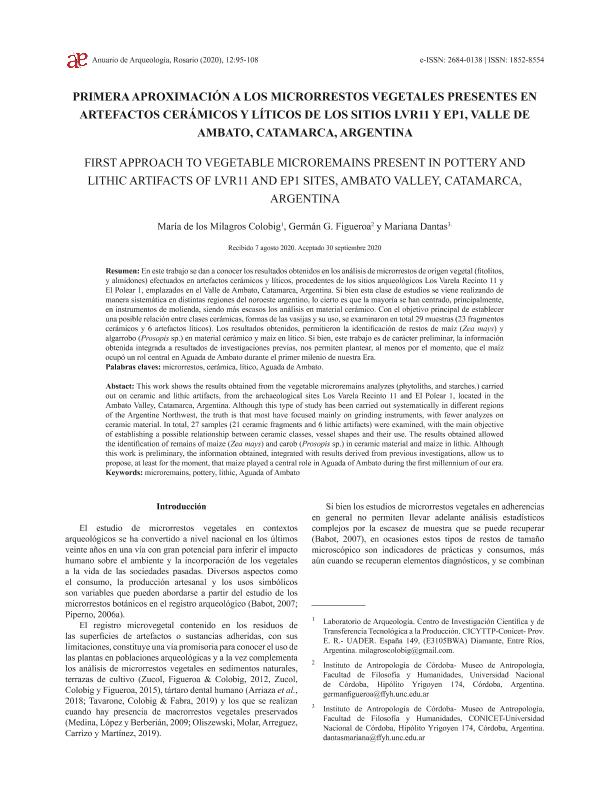Artículo
En este trabajo se dan a conocer los resultados obtenidos en los análisis de microrrestos de origen vegetal (fitolitos, y almidones) efectuados en artefactos cerámicos y líticos, procedentes de los sitios arqueológicos Los Varela Recinto 11 y El Polear 1, emplazados en el Valle de Ambato, Catamarca, Argentina. Si bien esta clase de estudios se viene realizando de manera sistemática en distintas regiones del noroeste argentino, lo cierto es que la mayoría se han centrado, principalmente, en instrumentos de molienda, siendo más escasos los análisis en material cerámico. Con el objetivo principal de establecer una posible relación entre clases cerámicas, formas de las vasijas y su uso, se examinaron en total 29 muestras (23 fragmentos cerámicos y 6 artefactos líticos). Los resultados obtenidos, permitieron la identificación de restos de maíz (Zea mays) y algarrobo (Prosopis sp.) en material cerámico y maíz en lítico. Si bien, este trabajo es de carácter preliminar, la información obtenida integrada a resultados de investigaciones previas, nos permiten plantear, al menos por el momento, que el maíz ocupó un rol central en Aguada de Ambato durante el primer milenio de nuestra Era. This work shows the results obtained from the vegetable microremains analyzes (phytoliths, and starches.) carried out on ceramic and lithic artifacts, from the archaeological sites Los Varela Recinto 11 and El Polear 1, located in the Ambato Valley, Catamarca, Argentina. Although this type of study has been carried out systematically in different regions of the Argentine Northwest, the truth is that most have focused mainly on grinding instruments, with fewer analyzes on ceramic material. In total, 27 samples (21 ceramic fragments and 6 lithic artifacts) were examined, with the main objective of establishing a possible relationship between ceramic classes, vessel shapes and their use. The results obtained allowed the identification of remains of maize (Zea mays) and carob (Prosopis sp.) in ceramic material and maize in lithic. Although this work is preliminary, the information obtained, integrated with results derived from previous investigations, allow us to propose, at least for the moment, that maize played a central role in Aguada of Ambato during the first millennium of our era.
Primera aproximación a los microrrestos vegetales presentes en artefactos cerámicos y líticos de los sitios LRV11 y EP1, Valle de Ambato, Catamarca, Argentina
Título:
First approach to vegetable microremains present in pottery and lithic artifacts of LRV11 and EP1 sites, Ambato Valley, Catamarca, Argentina
Fecha de publicación:
11/2020
Editorial:
Universidad Nacional de Rosario. Facultad de Humanidades y Artes. Escuela de Antropología. Departamento de Arqueología
Revista:
Anuario de Arqueología
ISSN:
2684-0138
e-ISSN:
1852-8554
Idioma:
Español
Tipo de recurso:
Artículo publicado
Clasificación temática:
Resumen
Palabras clave:
MICRORRESTOS
,
CERÁMICA
,
LÍTICO
,
AGUADA DE AMBATO
Archivos asociados
Licencia
Identificadores
Colecciones
Articulos(CICYTTP)
Articulos de CENTRO DE INV.CIENT.Y TRANSFERENCIA TEC A LA PROD
Articulos de CENTRO DE INV.CIENT.Y TRANSFERENCIA TEC A LA PROD
Articulos(IDACOR)
Articulos de INSTITUTO DE ANTROPOLOGIA DE CORDOBA
Articulos de INSTITUTO DE ANTROPOLOGIA DE CORDOBA
Citación
Colobig, María de Los Milagros; Figueroa, Germán Gabriel; Dantas, Mariana; Primera aproximación a los microrrestos vegetales presentes en artefactos cerámicos y líticos de los sitios LRV11 y EP1, Valle de Ambato, Catamarca, Argentina; Universidad Nacional de Rosario. Facultad de Humanidades y Artes. Escuela de Antropología. Departamento de Arqueología; Anuario de Arqueología; 12; 11-2020; 95-112
Compartir




